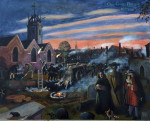
One of the points I make in my new book Where Did They Burn the Last Grand Master of the Knights Templar? A Walking Tour of Medieval Paris, is that entire cities such as Paris and London are virtual museums—all you have to do is dig.
I also discussed this in my June 6, 2015 blog post Stop the Presses: Skeletons and Not Buildings. A dig in the basement of a Paris supermarket revealed the final resting place (i.e., burial pit) of many medieval citizens (likely from a now defunct hospital located near the pit).
Moving across the Pond, Londoners have been looking forward to their new rail system that goes through Crossrail’s Liverpool Station. That is until they dug up a burial pit containing the remains of 30 plague victims. Plague pits are actually quite common across England. During the 1665 plague, it is estimated that more than 100,000 London citizens (approximately one-fifth of the city’s total population at the time) died of the plague. Read More London’s Black Death–1665


